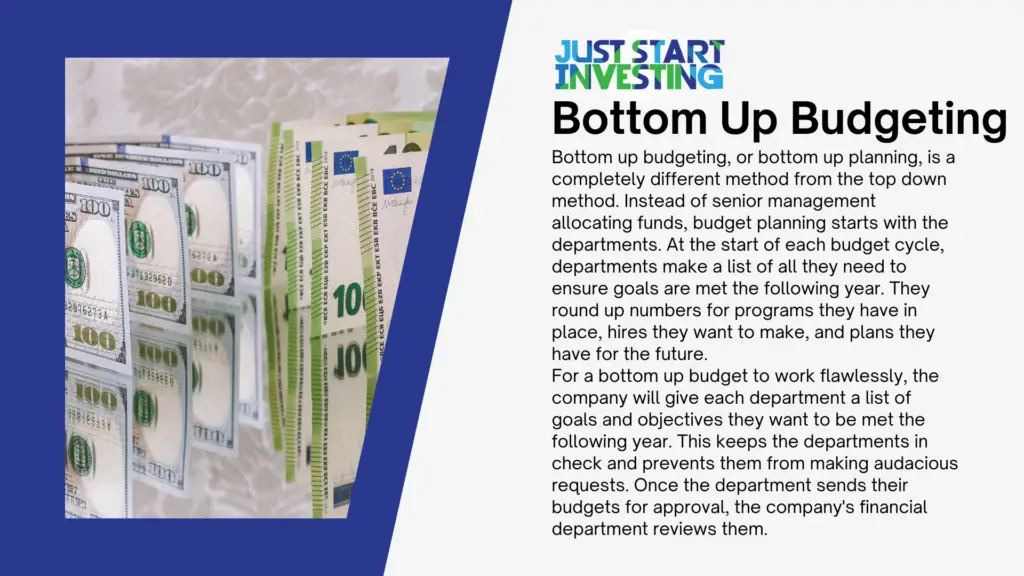When we talk about budgeting, most people think of it as personal finance. But did you know that even companies organize their spending in the form of budgets? The two prominent types of corporate budgets are top-down and bottom-up. Thus, the top-down vs. bottom-up debate has been going around for quite some time now.
While both types of budgets are different, what they both share is a set of pros and cons. In our guide, we will discuss the main talking points of the top-down vs. bottom-up budgeting debate. We will also talk about what businesses gain by using these budgets and what they lose. So, with all that out of the way, let’s begin.
Top Down vs Bottom Up Budgeting
The best way for a company to organize its spending is to allocate a budget to various sectors. We mentioned that two ways companies can do that are through the top-down or bottom-up budgeting methods. While we will explain both, you need to understand that both budgeting methods approach and finish the issue differently.
So make sure to continue reading to understand the fundamentals of both.
Top Down Budgeting
The top-down budget is a form of budget allocation that starts from the very top of the chain. Naturally, it can’t go much higher than with senior management. The most defining characteristic of this type of budget is that senior management allocates resources based on multiple factors. Probably the most impactful factor is past performance and market conditions. The senior management evaluates the past performance of each department and takes into consideration what the market dictates.
The second factor is the historical performance of each department. If a department meets its goals, senior management will evaluate whether the department needs more resources. The third factor that senior management considers is the previous year’s budget. This factor is different from past performances, as the latter looks into how each department performs.
The previous year’s budget serves as a guide to how many resources departments need to achieve their goals. Another characteristic of the top-down budget is that senior management will likely set aside funds to allocate later on if departments feel they need more resources to achieve their goals.
From there on, each department plans its own budget. As with any corporate budgeting method, there’s plenty of going back-and-forth between departments and senior management. This might be the reason why 55% of businesses opt to go for a bottom-up budgeting method.
Bottom Up Budgeting
Bottom-up budgeting, or bottom-up planning, is a completely different method from the top-down method. Instead of senior management allocating funds, budget planning starts with the departments. At the start of each budget cycle, departments make a list of all they need to ensure goals are met the following year. They round up numbers for programs they have in place, hires they want to make, and plans they have for the future.
For a bottom-up budget to work flawlessly, the company will give each department a list of goals and objectives they want to be met in the following year. This keeps the departments in check and prevents them from making audacious requests. Once the department sends their budgets for approval, the company’s financial department reviews them.

All in all, bottom-up budgeting seems like a more logical method for companies and organizations who want to streamline the resource allocation process. There are fewer back-and-forths going around with this method, which is why a larger percentage of companies opt for it.
But let’s look at the pros and cons of both for clarity purposes.
Pros And Cons of the Top Down Budgeting
Again, let’s start with the pros and cons of the top-down budgeting method.
Pros of Top-Down Budgeting
- It’s easier for senior management to align the company’s goals with the resources aligned to each department.
- Senior management can cap company spending and hold departments accountable if said goals aren’t met.
- If departments agree with the resource allocation of senior management, the process can go much faster.
Cons of Top-Down Budgeting
- Departments have no say in the initial planning and thus have a higher chance to disagree with the resource allocation process. This hinders speed and creates a lot of back-and-forth going on.
- Departments might be encouraged to spend all of the resources senior management has allocated to them. This creates a culture where a department will spend all the money in fear of budget cuts the following year despite achieving goals. By default, this is seen as an ineffective way of managing a company’s resources.
Pros and Cons of the Bottom Up Budgeting
Now, let’s look at where the bottom-up budget excels and where it lacks.
Pros of the Bottom Up Budgeting
- The bottom-up budget is oftentimes the most efficient way of corporate budget planning. Bottom-up planning follows several budget rules that make it more accurate when determining the resources each department requires to achieve goals.
- The departments have a deeper understanding of how markets work. Thus, departments know how to achieve maximum results. That means senior management can cut time by allocating the resources each department needs.
Cons of Bottom-Up Budgeting
- Departments don’t usually consider the financial needs of other departments. What this does is create an issue with senior management. The issue arises when a particular department asks for more than others.
- Departments also don’t take into account overall company goals. What departments care about is achieving their goals.
How To Choose the Right One?
Now that we’ve laid out the top-down vs bottom-up debate, how do you decide which one works best for your company? No doubt, the top-down and bottom-up methods excel in particular areas. But making the decision isn’t as clear-cut as you might think. Budget spending has no doubt changed over the past few years. Businesses have had to cut back on certain expenses due to external factors. According to a study, 69% of companies decreased ad spending in 2020.
A company’s ad department won’t cut back on ad spending unless senior management intervenes. This suggests a more top-down approach from most companies. But that doesn’t mean the top-down approach will work best for you. To make the right decision, you need to consider how your company operates. If company departments have strong leadership and are transparent with goals and strategies, giving more freedom can work better.
If departments prefer senior management should deal with goals and budget allocation, then the top-down approach is better. Ultimately, you should make the right choice based on not one but a few factors. If you want to know exactly where each department spends resources, go for the bottom-up budgeting method. If you want the opposite, then go for the top-down budgeting method.
Conclusion
The top-down vs. bottom-up budgeting debate is no doubt a hot topic in the corporate world. Both approaches are different and lead to different outcomes. While senior management ultimately makes the call, that doesn’t necessarily mean they should be the ones coming up with the plan. For more efficient and accurate spending, the bottom-up budgeting approach works better. For greater control of resource allocation, the top-down budgeting method is the obvious choice.

Partner at Vega Capital Management - a private funds management company.
An experienced portfolio manager with 10+ years of proven and reputable track record in investment management and financial analysis. Currently, a partner at one of the fastest-growing private fund management companies in southeast Europe, Kiril has been tending to a loyal international base of client-investors and partners. When he is not crunching numbers and increasing his client’s wealth, he reminisces about his Michelin-star restaurant cheffing years and fondness of the culinary arts.


